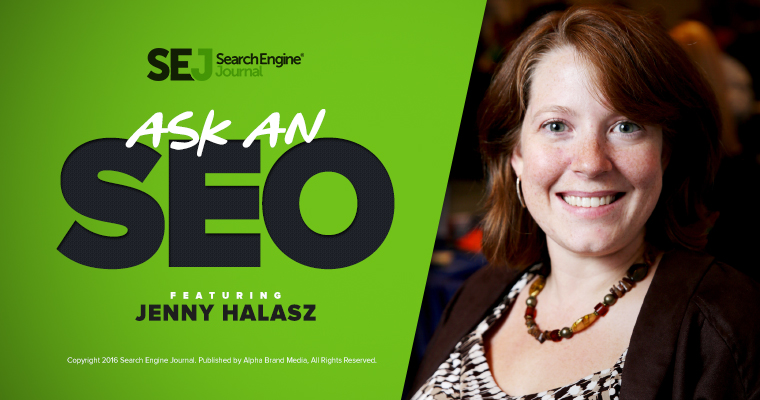Want to ask Jenny an SEO question for her bi-weekly column? Fill out our form or use #AskAnSEO on social media.
More great questions this week – keep them coming!
I disavow bad links monthly for the past 7 months, this consumes almost an entire day. How long should I continue to disavow? –Kevin S., Charlotte, North Carolina
I hate to give the standard “SEO” answer, but it depends. If the reason you are disavowing links is because you did some really bad things and got slammed for it, then you need to keep disavowing or removing the bad ones as they regenerate. Bad links are like Gremlins; they multiply, and they keep coming back. If you’re still finding lots to disavow every time you update, one of two things is happening:
- You’re disavowing too much: If you’re disavowing almost every link that comes in, rethink your definition of “bad”. It’s very possible you’re disavowing some good links (like reputable directories for local citations).
- You have some source of bad links that is still running: Check your credit card statements and make sure you’re not unknowingly paying for some “directory submission service” or something similar.
You need to keep disavowing on a regular basis (monthly is good) until your bad/good ratio shifts in favor of new good quality links.
If you’re just disavowing because someone told you to and you’ve never had an issue with Google penalties or manual actions, and you never did any bad link building, STOP! Disavowing links more than once a year is a complete waste of your time. It’s not a bad idea to do a link audit even if you haven’t run afoul of the Google gods, but you definitely don’t need to keep up a monthly disavowal.
Finally, I wonder why it’s taking you so long to process your disavowal each month. You should have a system of dumping all links into a database (or at least an Excel spreadsheet), cross-referencing what’s already been disavowed or reviewed, and then only reviewing the new links. I do this monthly for one of my clients, and it literally takes two hours or less to process approximately 5.5 thousand new links a month out of over 7 million. If you’re dedicating that much time (8+ hours!) to it a month, find a better way.
I have a large website with mostly list articles. Each post has over 30 lists so we use pagination and use page break after each 5 list splitting the long articles into paginated post. I saw another similar popular site using canonicals in the paginated content (2,3,4,5, etc) pointed to the first page. Is this a good practice or should I also do it to improve SEO for the paginated content? Thanks for your help. – A.
Paginated content is something that the search engines (especially Google) struggled with for a long time. The problem was, how could they index all of the content, but not send users to the second page of a three-page article, for example? And how could they clearly understand that the pages were connected?
It used to be that SEOs would noindex pages after the first page of an article to prevent this from happening, but then if the part of an article that was relevant to the search query was on page 2 or 3, Google couldn’t see it.
Enter Maile Ohye of Google and other smart people, who came up with canonicalization. This allowed Google to index all of the pages associated with a content piece (be it an article, a series of tips, or photos in a collection) and return only the first (canonical) page in search results. This was also a good solution, but it still made it difficult for Google to return a second or third page if that’s where the user’s query should lead.
That’s when they came up with the idea of rel=”next” and rel=”prev”. This allows the webmaster to clearly indicate the order each canonicalized page goes in, and also gives Google the freedom to return a deeper page (although they rarely do that I’ve seen). Here’s the post from Google on how to do it. And before you ask, yes, it’s fine to canonical the deeper pages either to themselves or to the first page of the article. Rel next and rel prev will override those canonicals.
So to answer your original question, you can absolutely use rel=canonical to point sub-pages to the first page. But implementing rel=”next” and rel=”prev” is even better.
Does anyone know whether full EV SSL provides more of an SEO boost than cheaper SSL licenses? I can’t find an answer to this anywhere… – Solomon K.
For those that don’t know, “EV” refers to “Extended Validation”. This is a process by which a human being (I know, I did it myself one summer) contacts the business requesting the certificate and obtains multiple forms of proof that they are who they say they are. It may include obtaining copies of their Articles of Incorporation, verification of their EIN (Employer Identification Number), verification of bank records, and other tests. It is costly and time-consuming, but organizations that complete it can display CA (Certificate Authority) seals from very well-known CAs like Verisign. This can increase a potential customers’ trust.
In reality, I doubt the average consumer has any idea what any of that means, and as long as they see the SSL lock icon on their browser window, they’re feeling fine.
![]()
There is no indication that SSL from one CA over another provides any additional SEO boost, but I don’t think that has been thoroughly tested. Since Google’s goal is simply to encrypt traffic, not to police the web or make judgments about who you should buy from, I can’t imagine that there is a preference.
I doubt that will change in the future since the only additional service that EV SSL provides is business authentication, and there are many quality websites that might become SSL but that would not be able to pass EV SSL requirements.
As it is, the jury is out among SEOs as to whether brochure style sites and sites that don’t have any forms or e-commerce (no data collection) really need SSL. I think it’s a good idea for everyone, especially as more free wifi services are injecting ads on websites to help pay for the services (I’d like to choose what ads show up on my website, wouldn’t you?). I’m advising clients to put it in their long-term plans. If you refresh your site or move to a new domain or host, that’s a good time to go ahead and go to https. But please, hire an SEO to help you with that transition! You can do far more damage to your site than the little boost you might get in return if you don’t know what you are doing.
That’s all we have time for this week, but we have lots more questions! Keep them coming and maybe you’ll see yours featured in a future post.
Image Credits
Featured Image: Image by Paulo Bobita
Screenshot by Jenny Halasz. Taken May 2016.




